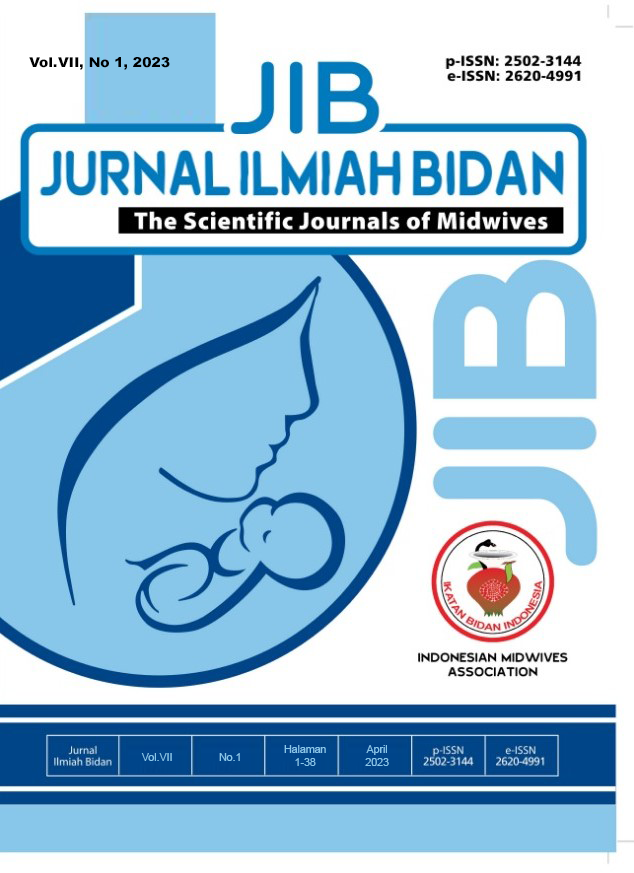PENGARUH SEBELUM DAN SESUDAH DILAKUKAN PIJAT LAKTASI TERHADAP PRODUKSI AIR SUSU IBU PADA IBU POSTPARTUM DI BPM MEILISA AFTY DEPOK PERIODE 14 JUNI – 14 JULI 2021
Abstract
Background: breast milk (ASI) is the best food for babies because it contains many nutrients. Data in Indonesia, only 1 in 2 infants under 6 months of age are exclusively breastfed and 38% of mothers stop breastfeeding due to lack of milk production. One method of increasing breast milk production is by lactation massage. The purpose of the study: was to determine the effect of before and after lactation massage on the production of brest milk on postpartum mothers at BPM Meilisa Afty Depok for the period June 14 – July 14, 2021. Methods: This study is an experimental study, with a one-group pre-test and post-test design. The number of samples as many as 35 postpartum mothers with a sampling technique that is purposive sampling. The lactation massage was carried out for 7 days and the measurement of milk production was carried out on the 1st and 7th days. Results: Breast milk production before lactation massage was found to all have less milk production as many as 35 people (100%) and after lactation massage it was found that most of them had sufficient milk production as many as 25 people (71.4%). The results of the Wilcoxon test showed the effect of before and after lactation massage on the production of breast milk on postpartum mothers at BPM Meilisa Afty (p value = 0.000 ≤0.05). Conclusion: the results showed that there was an increase in breast milk production after lactation massage was given. Suggestions: it is hoped that health workers can use lactation massage as a non-pharmacological alternative in an effort to increase breast milk production and educate mothers in the prenatal and postpartum periods regarding breastfeeding.
References
2. Fitiani, dkk. (2021). Efektifitas Pijat Oksitosin Dan Endorphin Pada Pengeluaran Asi Ibu Postpartum Di Puskesmas Alianyang Kota Pontianak. Jurnal Kebidanan Khatulistiwa, Vol. 7 No. 1, Januari 2021, hlm 9-14 P-ISSN 2460-1853, E-ISSN 2715-727X
3. Hartono. (2016). Massase Endorphine Terhadap Volume ASI Pada Ibu Post Partum. Jurnal Kebidanan , 209-215
4. Jahriani, N. (2019). Pengaruh Pijat Laktasi Terhadap Produksi ASI Pada Ibu Menyusui Di Kelurahan Sendang Sari Kabupaten Asahan Tahun 2019. Excellent Midwifery Journal. Vol. 2 No. 2, Oktober 2019. P-ISSN: 2620- 8237 E-ISSN: 26209829
5. Kamariyah. (2014). Kondisi psikologis mempengaruhi produksi ASI ibu menyusui di BPS Aski pakis sido kumpul surabaya. Jurnal illmiah kesehatan, Vol 7, No 12, Februari 2014, hal 29-36
6. Katmini dan Sholichah. (2020). Lactation Massage for Increasing Breast Milk Production in Postpartum Mothers. Journal for Quality in Public Health ISSN: 2614-4913 (Print), 2614- 4921 (Online) Vol. 4, No. 1, November 2020, pp: 104-113 DOI: 10.30994/jqph.v4i1.168
7. Kementerian Kesehatan Republik Indonesia. (2020). Profil Kesehatan Indonesia Tahun 2019. Jakarta: Kementrian Kesehatan RI
8. Kristiani, D., Latifah, L. 2013. Pengaruh Teknik Relaksasi Autogenik Terhadap Skala Nyeri pada Ibu
9. Post Operasi Sectio Caesarea (SC) di RSUD Banyumas. Skripsi: Universitas Jenderal Soedirman
Please find the rights and licenses in Jurnal Ilmiah Bidan (JIB). By submitting the article/manuscript of the article, the author(s) agree with this policy. No specific document sign-off is required.
1. License
The non-commercial use of the article will be governed by the Creative Commons Attribution license as currently displayed on Creative Commons Attribution-NonCommercial-ShareAlike 4.0 International License.
2. Author(s)' Warranties
The author warrants that the article is original, written by stated author(s), has not been published before, contains no unlawful statements, does not infringe the rights of others, is subject to copyright that is vested exclusively in the author and free of any third party rights, and that any necessary written permissions to quote from other sources have been obtained by the author(s).
3. User/Public Rights
JIB's spirit is to disseminate articles published are as free as possible. Under the Creative Commons license, JIB permits users to copy, distribute, display, and perform the work for non-commercial purposes only. Users will also need to attribute authors and JIB on distributing works in the journal and other media of publications. Unless otherwise stated, the authors are public entities as soon as their articles got published.
4. Rights of Authors
Authors retain all their rights to the published works, such as (but not limited to) the following rights;
- Copyright and other proprietary rights relating to the article, such as patent rights,
- The right to use the substance of the article in own future works, including lectures and books,
- The right to reproduce the article for own purposes,
- The right to self-archive the article (please read out deposit policy),
- The right to enter into separate, additional contractual arrangements for the non-exclusive distribution of the article's published version (e.g., post it to an institutional repository or publish it in a book), with an acknowledgment of its initial publication in this journal (Jurnal Ilmiah Bidan).
5. Co-Authorship
If the article was jointly prepared by more than one author, any authors submitting the manuscript warrants that he/she has been authorized by all co-authors to be agreed on this copyright and license notice (agreement) on their behalf, and agrees to inform his/her co-authors of the terms of this policy. JIB will not be held liable for anything that may arise due to the author(s) internal dispute. JIB will only communicate with the corresponding author.
6. Royalties
Being an open accessed journal and disseminating articles for free under the Creative Commons license term mentioned, author(s) aware that JIB entitles the author(s) to no royalties or other fees.
7. Miscellaneous
JIB will publish the article (or have it published) in the journal if the article’s editorial process is successfully completed. JIB's editors may modify the article to a style of punctuation, spelling, capitalization, referencing and usage that deems appropriate. The author acknowledges that the article may be published so that it will be publicly accessible and such access will be free of charge for the readers as mentioned in point 3.














